 The trend now in the kitchens of the dining industry across the globe is for chefs to use off cuts of meat that traditionally goes into mince. Challenged by the demand of more creativity, new taste sensations and rising costs of ingredients,
The trend now in the kitchens of the dining industry across the globe is for chefs to use off cuts of meat that traditionally goes into mince. Challenged by the demand of more creativity, new taste sensations and rising costs of ingredients,  Chefs are turning to these previously ignored cuts of meats for new inspiration and adopting new culinary techniques to make these cuts look presentable on the table, yet still taste good. For the customers, the question is are they paying more and getting less in terms of the cheaper cuts of meats used?Not really. Dealing with these "supercuts" are a new playground for chefs as we explore back to basics methods of slow cooking at lower temperatures to get the meats tenderized naturally and yet remain flavourful. That means more time and effort is spent on trimming the meats, gentle cooking that sometimes stretches more than 24hours at low temperatures similar or even lower to that like in the preparation of duck confit for example.The customer is still paying for professionalism and skill of the chef, something that is always forgotten in the percived value of a dish as it is not as visible as ingredients are on a plate. Some of these super cuts are available at local butcheries like Swiss Butcher in Greenwood Bukit Timah, Huber's @ Fairprice Finest and Esprito Santo @Great World City or Parkway Parade. Below is an interesting extract from the New York Times on this rising culinary trend:
Chefs are turning to these previously ignored cuts of meats for new inspiration and adopting new culinary techniques to make these cuts look presentable on the table, yet still taste good. For the customers, the question is are they paying more and getting less in terms of the cheaper cuts of meats used?Not really. Dealing with these "supercuts" are a new playground for chefs as we explore back to basics methods of slow cooking at lower temperatures to get the meats tenderized naturally and yet remain flavourful. That means more time and effort is spent on trimming the meats, gentle cooking that sometimes stretches more than 24hours at low temperatures similar or even lower to that like in the preparation of duck confit for example.The customer is still paying for professionalism and skill of the chef, something that is always forgotten in the percived value of a dish as it is not as visible as ingredients are on a plate. Some of these super cuts are available at local butcheries like Swiss Butcher in Greenwood Bukit Timah, Huber's @ Fairprice Finest and Esprito Santo @Great World City or Parkway Parade. Below is an interesting extract from the New York Times on this rising culinary trend:The Way We Eat: Super Cuts
By DANIEL PATTERSON
Published: May 7, 2006
By DANIEL PATTERSON
Published: May 7, 2006
New York Times
Pig's feet at the Ritz-Carlton in San Francisco? It's true. Beef cheeks at the French Laundry? Absolutely. Duck testicles at Del Posto? Really? Resoundingly, yes. The best chefs tend to cook in their restaurants what they themselves like to eat, and they have discovered, much to their delight, that customers are increasingly willing to pony up for the cheap, flavorful cuts of meat they love, like short ribs and pork belly. As Suzanne Goin of Lucques in Los Angeles put it, "Chefs never order fillets." Skip to next paragraphSo if we've been persuaded to move beyond primal muscles (i.e., steaks) at restaurants, then why aren't we cooking these inexpensive bits at home? Part of the answer is availability. Ground meat, made of pieces of the animal that are pulverized until unrecognizable, is the only nod you'll find in supermarkets to the fact that there is a world beyond steaks, ribs and shoulders. Your best bet for finding these cuts is a good butcher. In San Francisco, that place is the Golden Gate Meat Company (415-983-7800), a family-owned business that specializes in naturally raised meats. I was able to order (as a civilian, not a chef) everything called for in the accompanying recipes by the next day, with no minimum. The retail prices ranged from $2.25 a pound for the pig's feet to $4.50 a pound for the beef cheeks, and they'll ship anywhere. Ethnic markets also tend to carry the tough, fatty meats that mainstream America has yet to try at home.
Another reason we tend to stick with common cuts is our culinary xenophobia. Maybe steaks are our gastronomic clean, well-lighted place, staving off reminders that our meal came from a once-living animal. The fact is that every steak we eat originally came with a head, feet and other extremities, most of which, according to the National Cattlemen's Beef Association, are shipped overseas.
And then there's the yuck factor. Pig's feet come from the butcher looking like what they are: feet. It is clear that a pig was using them recently. The same might be said for tongue, which bears more than a passing resemblance to our own. But there's a reason that top chefs include them in menus filled with caviar and truffles: they are utterly, beguilingly delicious, in a way that no primal muscle can approach.
Now, I realize that there's one more impediment to cooking these things at home: venturing into the land of unfamiliar foodstuffs can be a bit nerve-racking. So by way of introduction, here are three easy-to-follow preparations for cuts that offer big flavor payoff with little financial investment.
Pig's feet are not only easy to cook, but also forgiving of most transgressions — long, slow, moist heat will bring them to perfection every time. This converts the muscles' tough connective tissue to gelatin, which, along with its higher fat content, gives the meat a luscious mouth feel and depth of flavor. Imagine a crisp breaded crust giving way to a warm gush of soft fat and tender meat, the intense pork flavor balanced by herbs and gently cooked onions and garlic. The first part is straightforward, if a little time-consuming: simmer the feet with chicken stock and salt until the meat and fat pull easily from the bone. Next comes the trickier part, but don't worry — they don't have to be perfect. Let them cool slightly, remove the bones, fill them with the herb-and-onion mixture and then wrap them tightly in plastic and refrigerate. The natural gelatin in the feet will bind the meat, so when it is cold it will be a solid cylinder. Then cut thick slices, bread them and fry them. Served with a potato salad dressed with mustard vinaigrette, it's a delicious alternative to a typical meat-and-potato dish.
For the more faint of heart, beef cheeks are simpler to cook. The only trick is in the trimming, because the fat and silvery connective tissue cling tightly to the meat they encapsulate. Your butcher should do this for you; if not, you can trim the extra fat after they cook and cool. Beef cheeks have an explosively beefy flavor and succulent texture that belie their somewhat banal appearance. And unlike steak, which requires careful monitoring, they can handle a bit of benign neglect and still deliver an impressive result — just make sure to keep the oven temperature low.
The lamb's-neck rillettes is the easiest recipe of all. The meat is seasoned a day ahead and then cooked slowly in olive oil until very tender. The lamb is cooled to room temperature, pulled from the bone and shredded, then tossed with some of the cooking oil and refrigerated. Spread on toasted country bread with a little mustard, it makes a wonderful dinner-party canapé — or in my case, a fast breakfast.
Pig's feet at the Ritz-Carlton in San Francisco? It's true. Beef cheeks at the French Laundry? Absolutely. Duck testicles at Del Posto? Really? Resoundingly, yes. The best chefs tend to cook in their restaurants what they themselves like to eat, and they have discovered, much to their delight, that customers are increasingly willing to pony up for the cheap, flavorful cuts of meat they love, like short ribs and pork belly. As Suzanne Goin of Lucques in Los Angeles put it, "Chefs never order fillets." Skip to next paragraphSo if we've been persuaded to move beyond primal muscles (i.e., steaks) at restaurants, then why aren't we cooking these inexpensive bits at home? Part of the answer is availability. Ground meat, made of pieces of the animal that are pulverized until unrecognizable, is the only nod you'll find in supermarkets to the fact that there is a world beyond steaks, ribs and shoulders. Your best bet for finding these cuts is a good butcher. In San Francisco, that place is the Golden Gate Meat Company (415-983-7800), a family-owned business that specializes in naturally raised meats. I was able to order (as a civilian, not a chef) everything called for in the accompanying recipes by the next day, with no minimum. The retail prices ranged from $2.25 a pound for the pig's feet to $4.50 a pound for the beef cheeks, and they'll ship anywhere. Ethnic markets also tend to carry the tough, fatty meats that mainstream America has yet to try at home.
Another reason we tend to stick with common cuts is our culinary xenophobia. Maybe steaks are our gastronomic clean, well-lighted place, staving off reminders that our meal came from a once-living animal. The fact is that every steak we eat originally came with a head, feet and other extremities, most of which, according to the National Cattlemen's Beef Association, are shipped overseas.
And then there's the yuck factor. Pig's feet come from the butcher looking like what they are: feet. It is clear that a pig was using them recently. The same might be said for tongue, which bears more than a passing resemblance to our own. But there's a reason that top chefs include them in menus filled with caviar and truffles: they are utterly, beguilingly delicious, in a way that no primal muscle can approach.
Now, I realize that there's one more impediment to cooking these things at home: venturing into the land of unfamiliar foodstuffs can be a bit nerve-racking. So by way of introduction, here are three easy-to-follow preparations for cuts that offer big flavor payoff with little financial investment.
Pig's feet are not only easy to cook, but also forgiving of most transgressions — long, slow, moist heat will bring them to perfection every time. This converts the muscles' tough connective tissue to gelatin, which, along with its higher fat content, gives the meat a luscious mouth feel and depth of flavor. Imagine a crisp breaded crust giving way to a warm gush of soft fat and tender meat, the intense pork flavor balanced by herbs and gently cooked onions and garlic. The first part is straightforward, if a little time-consuming: simmer the feet with chicken stock and salt until the meat and fat pull easily from the bone. Next comes the trickier part, but don't worry — they don't have to be perfect. Let them cool slightly, remove the bones, fill them with the herb-and-onion mixture and then wrap them tightly in plastic and refrigerate. The natural gelatin in the feet will bind the meat, so when it is cold it will be a solid cylinder. Then cut thick slices, bread them and fry them. Served with a potato salad dressed with mustard vinaigrette, it's a delicious alternative to a typical meat-and-potato dish.
For the more faint of heart, beef cheeks are simpler to cook. The only trick is in the trimming, because the fat and silvery connective tissue cling tightly to the meat they encapsulate. Your butcher should do this for you; if not, you can trim the extra fat after they cook and cool. Beef cheeks have an explosively beefy flavor and succulent texture that belie their somewhat banal appearance. And unlike steak, which requires careful monitoring, they can handle a bit of benign neglect and still deliver an impressive result — just make sure to keep the oven temperature low.
The lamb's-neck rillettes is the easiest recipe of all. The meat is seasoned a day ahead and then cooked slowly in olive oil until very tender. The lamb is cooled to room temperature, pulled from the bone and shredded, then tossed with some of the cooking oil and refrigerated. Spread on toasted country bread with a little mustard, it makes a wonderful dinner-party canapé — or in my case, a fast breakfast.
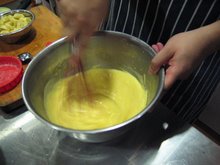

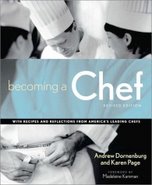
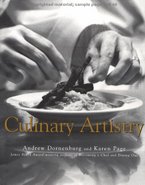


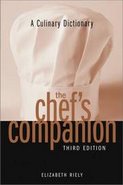

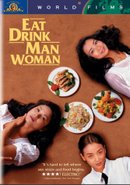
.jpg)
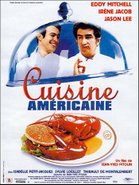











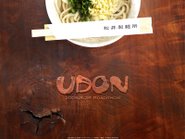





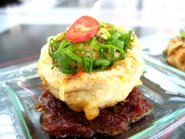


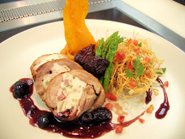
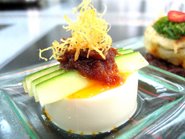
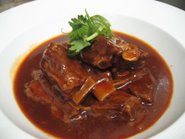
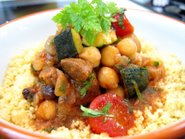
























































1 comment:
i hope you can help to write "Food & Travel" story in Chinese leh....
Post a Comment